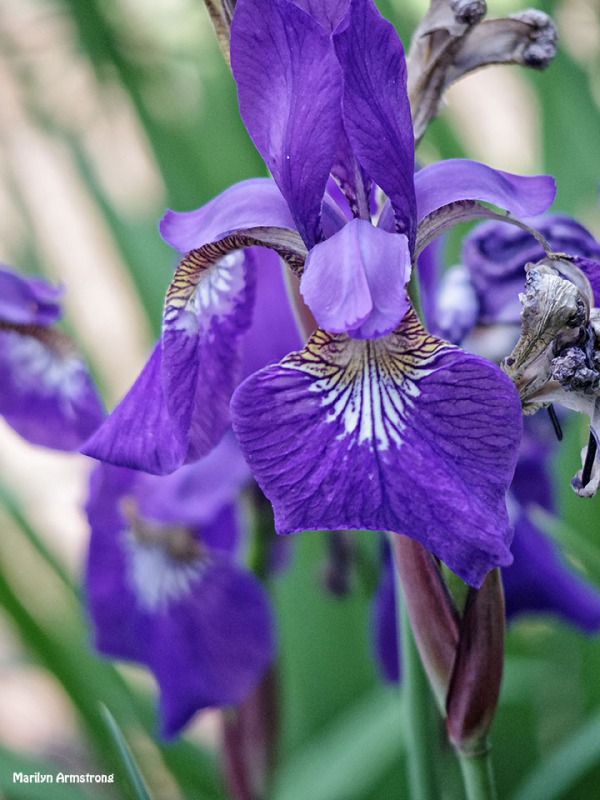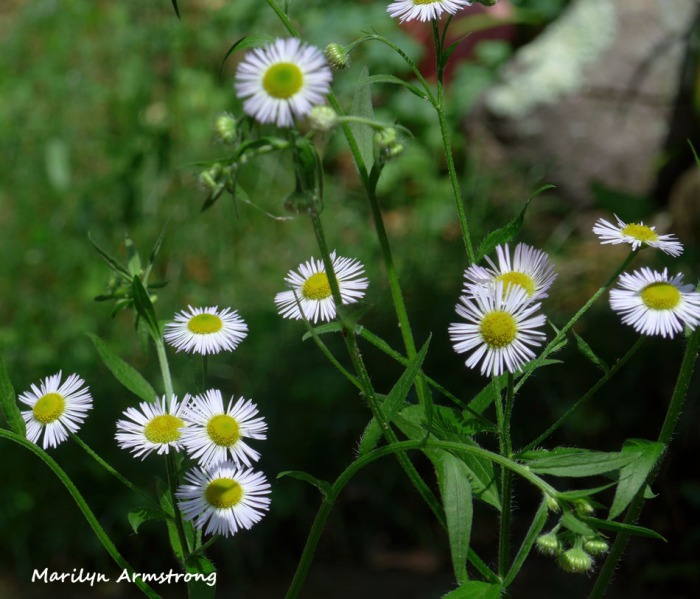FOTD – June 19 – Iris and other flowers
Once upon a time, about 23 years ago, we moved from Boston to the Blackstone Valley. I wanted a garden. Badly. I’d been living in cities for more than 20 years before this and I was thrilled to have some land. It wasn’t, as I soon learned, particularly good land. It was heavily laced with rocks, some of which were similar to planet-sized boulders.
Still, it was our land. Owen and I moved some boulders out of the woods. They lined the garden and we filled it with topsoil. And then, knowing very little about what would grow well in this area, we planted. Too tightly and without considering how difficult it would be to get into the garden to maintain it. I also never had to deal with deer munching on flowers or skunks digging up bulbs.





I didn’t expect to get old. Does anyone expect to get old? Age is permanently an unwelcome surprise, but I maintain it beats out the alternative — dying young. I never imagined a time would come when I couldn’t get into my garden to do basic chores, but it happened.
Most of all, I planted roses. The fancy roses died the first winter, but the hedge roses seem impermeable to anything nature can throw at them. I planted a lot of daylilies, including a lot of Chinese daylilies in a range of colors. They bloomed for one or two seasons and one pink one bloomed for almost a decade. What really did well? Columbine. From two or three plants, they have spread out and we have a few dozen of them every year.

The wild flowers, native to the region, have all done well. Solomon’s Seal only needed to move from the darkness to the light. I also transplanted spiderwort and daylilies from along the road and the woods and they are the stalwarts of what remains of the garden. Crocuses still bloom as do the daffodils and we have acquired narcissus, probably via bird. The wild strawberries keep growing, too.

We have wild asters and Queen Anne’s Lace, violets and giant clover. The holly tree has grown huge. It houses close to a dozen bird’s nests — which makes it difficult to trim since I don’t want to upset my tenants. The holly tree has become an apartment complex for birds.

Among the other flowers we planted were irises. They were among the first to go, too. Apparently iris have absolutely delicious bulbs. Every last one was eventually eaten by skunk. They also ate the Goat’s Beard and allium in the other garden. For some years, we had incredible hollyhocks and one year, they all died. I was told that the alkalinity of the soil had changed. Why? Who knows?
Today Owen tore out a couple of hundred feet of kudzu before it had a chance to take over the entire yard which it did last year. Known as “mile-a-minute” and “the vine that ate the South,” this creeping, climbing perennial vine terrorizes native plants all over the southeastern United States and is making its way into the Midwest, Northeast and even Oregon.

We cut the kudzu and the bittersweet down in November. So far, it has not entirely grown back, but it grows so fast. Ignore it for a week and it will have added seven extra feet. Kudzu and bittersweet are both lethal to native trees and flowers and can destroy entire ecosystems. We can continue to cut it back. But overhead where no one can reach it, it strangles trees from the top and those vines have trunks the size of trees. It has killed trees including some pretty big oaks. All we can do is keep cutting it back.

Categories: #Flowers, #FOTD, #gallery, #Photography, Anecdote, Cee's Photo Challenge, Flower of the day, Gardens, lily, roses, wildflowers


Your garden is an apt metaphor for life.
I marvel that you bring forth such beauty with your own hands & hard work.
LikeLike
If I were less broken, it would be a lot better. We are also suffering serious damage from drought and warmer winters. But so is the rest of the world. We all do the best we can!
LikeLike
Indeed. The best we can.
LikeLike
Gorgeous irises and lily 😀 😀 Wonderful fun post 😀
LikeLike
Thanks Cee. Half of our day lilies are all yellow and dying, but the OTHER half look fine. I’m trying to figure out WHY. Maybe we need fertilizer?
LikeLiked by 1 person
Gardens are a lot of work, ours is quite large. I heard of kudzu for the first time a few weeks ago. We also have alien plants but not that one.
LikeLike
Feel yourself blessed. Kudzu, which was never in our part of the country, has moved on up as climate change has warmed our winters. It’s horrible. I have nightmares about it.
LikeLike
Even plants have predators that thrive on them.
LikeLike
Everything eats plants or so it seems. But those strangling vines — none of which are local and all of which were brought here from China and Japan — are absolutely lethal in this environment. We have, by now, learned to stop bringing in plants from other places. It’s just a bit too late.
LikeLiked by 1 person
We have one creeper like that here. A yellow/ pale green vine which is call “amar bale” and that too strangled plants and hedges. I remember my grandfather wrestling with it
LikeLike
Beautiful! Have a great week, Marilyn. The sun is supposed to shine–finally! ❤ xo
LikeLike
We got a few days of sun and two long days of drenching rain. At least we get a break between storms! It’s not much of a summer yet, but maybe it will improve.
LikeLike